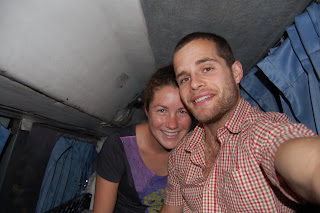
After venturing the incredibly chaotic streets of Delhi for a couple of days we took an 18-hour train journey out to the far western region of Rajasthan. We started in the majestic, "golden city" of Jaisalmer, and it truly is golden (think Aladin). All of the buildings are made of blocks from a local sandstone mine, and they often bare beautiful, intricate hand-chiseled designs. Behind us rises the impressive Jaisalmer Fort. Built in 1156 by the Rajputs, this massive fort contains a maze of narrow streets, temples, and palaces colored by a large population of people who still reside there.

Captivating architecture in the wandering streets of the fort. Unfortunately, the fort itself has little protection from the impact of tourism and residents and time is taking it's toll- there isn't even an entrance fee.
 Also inside the fort, we joined in on a game of Indian Billiards. A cross between shuffleboard and pool, we were immediately very entertained by this game and will be designing our own board upon arrival back home.
Also inside the fort, we joined in on a game of Indian Billiards. A cross between shuffleboard and pool, we were immediately very entertained by this game and will be designing our own board upon arrival back home. Lauren mixing with the local people and cow population.
Lauren mixing with the local people and cow population.
This is undoubtedly the most elaborate graveyard we've ever come across. Typical of other stonework in Jaisalmer, these temple-like sandstone structures are adorned with incredibly detailed hand-carved designs.

This was a ridiculous endeavor that we couldn't pass up. Westerners heading out on camels into the unbearable 110 degree heat in order to get a taste of the desert life that was and still is so prominent in many parts of Rajasthan. Camels are goofy and temperamental, and riding them has it's ups and downs: they are amusingly tall, but the ride is surprisingly bumpy and sitting requires quite a leg-spread, which Jay could only bare for about 20 minutes at a time before opting to walk.
 While the daytime temperatures were suffocating, mornings and evenings were a payoff. We had a small fire and slept out on the sand dunes.
While the daytime temperatures were suffocating, mornings and evenings were a payoff. We had a small fire and slept out on the sand dunes.
It's true, cows are indeed sacred in India. Walking narrow streets can feel perilous as we sneak between the heavy-footed animals. McDonalds is known to serve tasty Indian vegi-burgers.
 The beginnings of our delicious Indian street food. On the streets it's easy to fill up on well under a dollar, though we have to choose carefully so we don't end up bed-ridden. Also, as you may have guessed, the food can be very spicy. The Indian people don't hide their laughter at the sight of our nontraditional, clumsy eating, and the sweat pouring down us.
The beginnings of our delicious Indian street food. On the streets it's easy to fill up on well under a dollar, though we have to choose carefully so we don't end up bed-ridden. Also, as you may have guessed, the food can be very spicy. The Indian people don't hide their laughter at the sight of our nontraditional, clumsy eating, and the sweat pouring down us. After Jaisalmer we bussed east to Jodhpur, home to busy markets and overlooked by the mighty Mehrangarh. This castle is truly an architectural masterpiece and we took an impressive tour through it's elaborate complex of battle gates, courtyards, museums, palaces, and temples. It is still run by the descendants of the Maharaja of Jodhpur.
After Jaisalmer we bussed east to Jodhpur, home to busy markets and overlooked by the mighty Mehrangarh. This castle is truly an architectural masterpiece and we took an impressive tour through it's elaborate complex of battle gates, courtyards, museums, palaces, and temples. It is still run by the descendants of the Maharaja of Jodhpur. An example of the intricately carved, latticed-walls inside the castle.
 The muscular walls of the Mehrangarh (still complete with war cannons) rise naturally from the cliffs and overlook the "blue city" of Jodhupur.
The muscular walls of the Mehrangarh (still complete with war cannons) rise naturally from the cliffs and overlook the "blue city" of Jodhupur. Though not quite as blue as it once was, it is still a captivating sight. The indigo coloring was traditionally said to keep the buildings cool in the summer heat and repel mosquitoes. We stayed with an especially welcoming family in the lower right side of this picture.
Though not quite as blue as it once was, it is still a captivating sight. The indigo coloring was traditionally said to keep the buildings cool in the summer heat and repel mosquitoes. We stayed with an especially welcoming family in the lower right side of this picture. 











